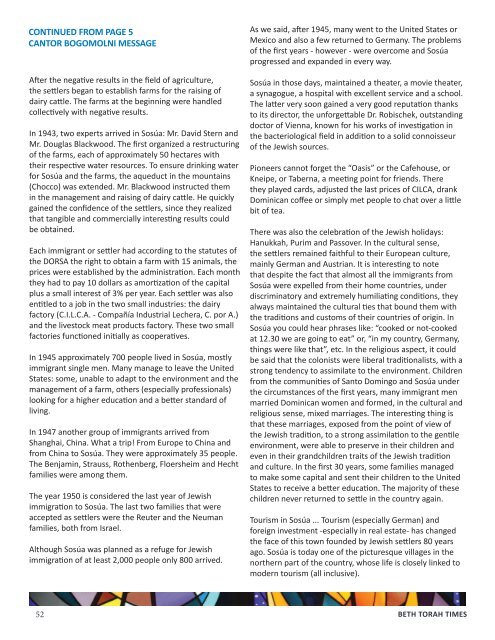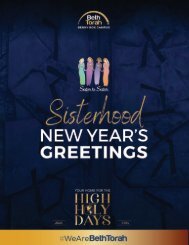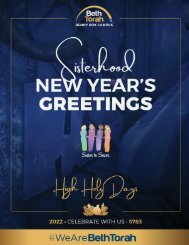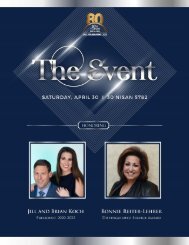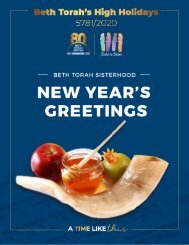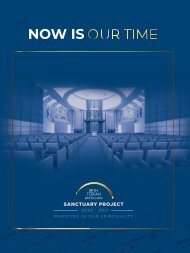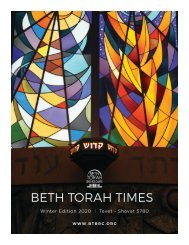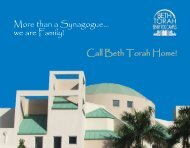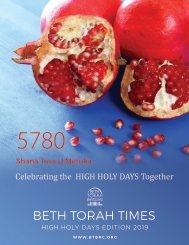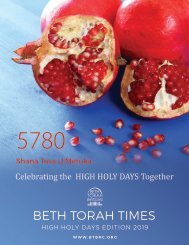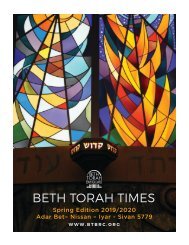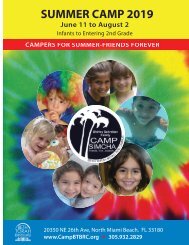Create successful ePaper yourself
Turn your PDF publications into a flip-book with our unique Google optimized e-Paper software.
CONTINUED FROM PAGE 5<br />
CANTOR BOGOMOLNI MESSAGE<br />
After the negative results in the field of agriculture,<br />
the settlers began to establish farms for the raising of<br />
dairy cattle. The farms at the beginning were handled<br />
collectively with negative results.<br />
In 1943, two experts arrived in Sosúa: Mr. David Stern and<br />
Mr. Douglas Blackwood. The first organized a restructuring<br />
of the farms, each of approximately 50 hectares with<br />
their respective water resources. To ensure drinking water<br />
for Sosúa and the farms, the aqueduct in the mountains<br />
(Chocco) was extended. Mr. Blackwood instructed them<br />
in the management and raising of dairy cattle. He quickly<br />
gained the confidence of the settlers, since they realized<br />
that tangible and commercially interesting results could<br />
be obtained.<br />
Each immigrant or settler had according to the statutes of<br />
the DORSA the right to obtain a farm with 15 animals, the<br />
prices were established by the administration. Each month<br />
they had to pay 10 dollars as amortization of the capital<br />
plus a small interest of 3% per year. Each settler was also<br />
entitled to a job in the two small industries: the dairy<br />
factory (C.I.L.C.A. - Compañía Industrial Lechera, C. por A.)<br />
and the livestock meat products factory. These two small<br />
factories functioned initially as cooperatives.<br />
In 1945 approximately 700 people lived in Sosúa, mostly<br />
immigrant single men. Many manage to leave the United<br />
States: some, unable to adapt to the environment and the<br />
management of a farm, others (especially professionals)<br />
looking for a higher education and a better standard of<br />
living.<br />
In 1947 another group of immigrants arrived from<br />
Shanghai, China. What a trip! From Europe to China and<br />
from China to Sosúa. They were approximately 35 people.<br />
The Benjamin, Strauss, Rothenberg, Floersheim and Hecht<br />
families were among them.<br />
The year 1950 is considered the last year of Jewish<br />
immigration to Sosúa. The last two families that were<br />
accepted as settlers were the Reuter and the Neuman<br />
families, both from Israel.<br />
Although Sosúa was planned as a refuge for Jewish<br />
immigration of at least 2,000 people only 800 arrived.<br />
As we said, after 1945, many went to the United States or<br />
Mexico and also a few returned to Germany. The problems<br />
of the first years - however - were overcome and Sosúa<br />
progressed and expanded in every way.<br />
Sosúa in those days, maintained a theater, a movie theater,<br />
a synagogue, a hospital with excellent service and a school.<br />
The latter very soon gained a very good reputation thanks<br />
to its director, the unforgettable Dr. Robischek, outstanding<br />
doctor of Vienna, known for his works of investigation in<br />
the bacteriological field in addition to a solid connoisseur<br />
of the Jewish sources.<br />
Pioneers cannot forget the “Oasis” or the Cafehouse, or<br />
Kneipe, or Taberna, a meeting point for friends. There<br />
they played cards, adjusted the last prices of CILCA, drank<br />
Dominican coffee or simply met people to chat over a little<br />
bit of tea.<br />
There was also the celebration of the Jewish holidays:<br />
Hanukkah, Purim and Passover. In the cultural sense,<br />
the settlers remained faithful to their European culture,<br />
mainly German and Austrian. It is interesting to note<br />
that despite the fact that almost all the immigrants from<br />
Sosúa were expelled from their home countries, under<br />
discriminatory and extremely humiliating conditions, they<br />
always maintained the cultural ties that bound them with<br />
the traditions and customs of their countries of origin. In<br />
Sosúa you could hear phrases like: “cooked or not-cooked<br />
at 12.30 we are going to eat” or, “in my country, Germany,<br />
things were like that”, etc. In the religious aspect, it could<br />
be said that the colonists were liberal traditionalists, with a<br />
strong tendency to assimilate to the environment. Children<br />
from the communities of Santo Domingo and Sosúa under<br />
the circumstances of the first years, many immigrant men<br />
married Dominican women and formed, in the cultural and<br />
religious sense, mixed marriages. The interesting thing is<br />
that these marriages, exposed from the point of view of<br />
the Jewish tradition, to a strong assimilation to the gentile<br />
environment, were able to preserve in their children and<br />
even in their grandchildren traits of the Jewish tradition<br />
and culture. In the first 30 years, some families managed<br />
to make some capital and sent their children to the United<br />
States to receive a better education. The majority of these<br />
children never returned to settle in the country again.<br />
Tourism in Sosúa ... Tourism (especially German) and<br />
foreign investment -especially in real estate- has changed<br />
the face of this town founded by Jewish settlers 80 years<br />
ago. Sosúa is today one of the picturesque villages in the<br />
northern part of the country, whose life is closely linked to<br />
modern tourism (all inclusive).<br />
52 <strong>BETH</strong> <strong>TORAH</strong> <strong>TIMES</strong>


